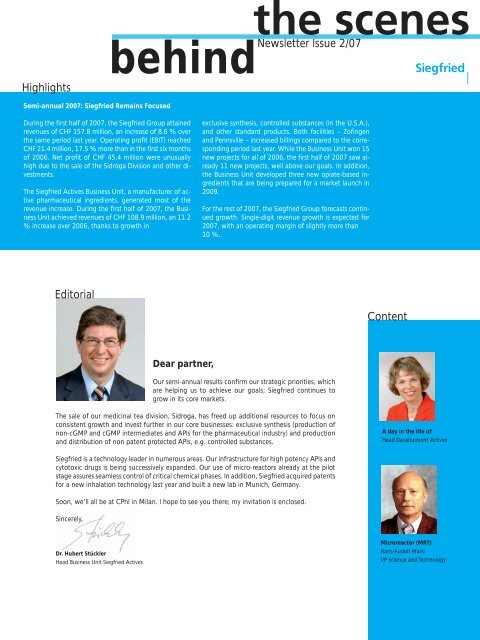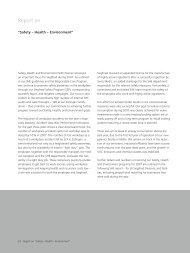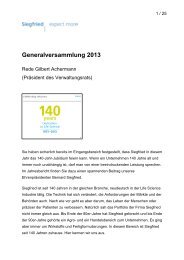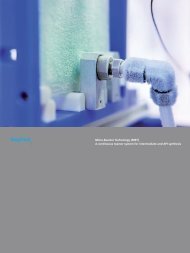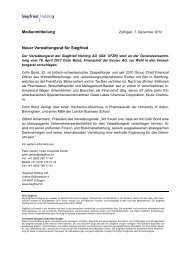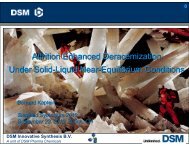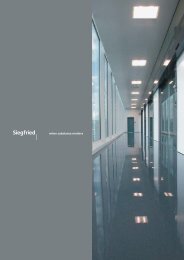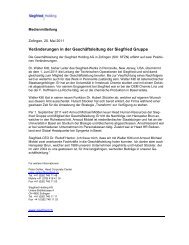Create successful ePaper yourself
Turn your PDF publications into a flip-book with our unique Google optimized e-Paper software.
Highlights<br />
behind<br />
Newsletter Issue 2/07<br />
Semi-annual 2007: <strong>Siegfried</strong> Remains Focused<br />
During the first half of 2007, the <strong>Siegfried</strong> Group attained<br />
revenues of CHF 157.8 million, an increase of 8.6 % over<br />
the same period last year. Operating profit (EBIT) reached<br />
CHF 21.4 million, 17.5 % more than in the first six months<br />
of 2006. Net profit of CHF 45.4 million were unusually<br />
high due to the sale of the Sidroga Division and other divestments.<br />
The <strong>Siegfried</strong> Actives Business Unit, a manufacturer of active<br />
pharmaceutical ingredients, generated most of the<br />
revenue increase. During the first half of 2007, the Business<br />
Unit achieved revenues of CHF 108.9 million, an 11.2<br />
% increase over 2006, thanks to growth in<br />
exclusive synthesis, controlled substances (in the U.S.A.),<br />
and other standard products. Both facilities – Zofingen<br />
and Pennsville – increased billings compared to the corresponding<br />
period last year. While the Business Unit won 15<br />
new projects for all of 2006, the first half of 2007 saw already<br />
11 new projects, well above our goals. In addition,<br />
the Business Unit developed three new opiate-based ingredients<br />
that are being prepared for a market launch in<br />
2009.<br />
For the rest of 2007, the <strong>Siegfried</strong> Group forecasts continued<br />
growth. Single-digit revenue growth is expected for<br />
2007, with an operating margin of slightly more than<br />
10 %.<br />
Editorial<br />
Content<br />
Dear partner,<br />
Our semi-annual results confirm our strategic priorities, which<br />
are helping us to achieve our goals; <strong>Siegfried</strong> continues to<br />
grow in its core markets.<br />
The sale of our medicinal tea division, Sidroga, has freed up additional resources to focus on<br />
consistent growth and invest further in our core businesses: exclusive synthesis (production of<br />
non-cGMP and cGMP intermediates and APIs for the pharmaceutical industry) and production<br />
and distribution of non patent protected APIs, e.g. controlled substances.<br />
A day in the life of<br />
Head Development Actives<br />
<strong>Siegfried</strong> is a technology leader in numerous areas. Our infrastructure for high potency APIs and<br />
cytotoxic drugs is being successively expanded. Our use of micro-reactors already at the pilot<br />
stage assures seamless control of critical chemical phases. In addition, <strong>Siegfried</strong> acquired patents<br />
for a new inhalation technology last year and built a new lab in Munich, Germany.<br />
Soon, we’ll all be at CPhl in Milan. I hope to see you there; my invitation is enclosed.<br />
Sincerely,<br />
Dr. Hubert Stückler<br />
Head Business Unit <strong>Siegfried</strong> Actives<br />
Microreactor (MRT)<br />
Hans-Rudolf Marti<br />
VP Science and Technology
Microreactor Technology (MRT)<br />
1. General<br />
A quick search for a definition of Microreactor technology (MRT) produces<br />
at least two versions. One is that from the viewpoint of the manufacturer<br />
of MRT devices:<br />
...components produced by using microtechnology techniques with channels<br />
of diameters of smaller than 1 mm...<br />
Or the viewpoint of the chemist:<br />
A microsystem for chemical and biochemical reactions...as well as analytical<br />
systems. Its small reaction volumes and high heat and mass transfer<br />
rates allow for precise adjustment of process conditions, short response<br />
times, and defined residence times, resulting in greater process control<br />
and higher yields and selectivity. (citation from: www.answers.com).<br />
2. <strong>Siegfried</strong> and MRT<br />
Upon initiation by Max Widmer 2003 <strong>Siegfried</strong> started studying MRT as<br />
a possible expansion of its technological toolbox. There were already several<br />
companies offering reactor units for industrial use or even complete<br />
computerized systems for the optimisation of chemical reactions. The<br />
companies offered to check the feasibility of our reaction candidates as a<br />
service and –to get started at all- we used it for a few of our candidates.<br />
However it quickly became clear that we needed our own MRT setup in<br />
house to develop expertise that would allow us to be able to rapidly check<br />
potential reactions from our customers. Having concrete examples are<br />
mandatory for convincing customers as well as our development and<br />
plant chemists – it is not enough to identify such opportunities just on<br />
paper! In 2005 we opened up the MRT laboratory headed by Dr. Beat<br />
Weber and operated by Norbert Schärer. The goal we set was to have one<br />
reaction candidate on industrial scale within the first year.<br />
It is in short a technology that couples the miniaturisation of chemical reactors<br />
with optimal reaction conditions and eliminating “classical” scaleup<br />
problems. By virtue of the small volume of reactants reacting at any<br />
given time safety concerns disappear, therefore minimizing the need for<br />
process risk analysis and allowing to carry out hazardous transformations<br />
otherwise not suitable for batch processing.<br />
It is therefore easy to list the advantages of MRT<br />
• The miniaturisation of the reactor allows to run demanding<br />
reactions under conditions that are impossible to perform on larger<br />
scale.<br />
• It substantially expands the optimisation “range” of a reaction or<br />
even<br />
• enables a large scale production of reactions not possible in standard<br />
batch reactors. E.g. if an initial conversion yields a reactive or unstable<br />
intermediate a (immediate) subsequent stabilisation step can be<br />
added<br />
• better temperature control results in higher yields and cleaner<br />
conversions (selectivity)<br />
• an optimisation can be done quite fast in an “on-line” mode by<br />
adjusting e.g. feed rate parameters<br />
• an increased output can be reached by numbering up the reactors<br />
• low investment even for industrial scale size for MRT devices<br />
Still, MRT is a technique in development and it takes substantial efforts<br />
and quite some experience until it can be used like any other method in<br />
a companie’s chemical “toolbox”.<br />
Of course only a part of the reactions are suited for MRT studies. Best<br />
candidates are<br />
• fast<br />
• mixing controlled<br />
• exothermic reactions<br />
• with a narrow temperature “window” and<br />
• a high safety risk<br />
<strong>Reaction</strong>s that e.g. have to be performed now at very low temperatures<br />
to ensure the desired temperature in the mixing/reaction zone can be<br />
done at much higher temperature. We have even seen examples where<br />
reactions that need to be carried out at sub zero temperatures in a batch<br />
reactor can be run at ambient temperature, skipping the need for investments<br />
in cryogenic equipment.<br />
Investigation of <strong>Siegfried</strong>’s reaction portfolio as well as some literature<br />
references led to the conclusion that about one out of five conversions<br />
could be candidates for –and should perform advantageously with MRTand<br />
maybe one out of ten would be worthwile to check on lab scale.<br />
Finetuning a micro reactor<br />
3. Build up of a new Technology in House<br />
Of course we started with enthusiasm. However, in this particular case it<br />
was not quite sufficient. The hurdles we encountered were substantially<br />
higher than anticipated and resulted in setbacks. Chemical reactions are<br />
often quite sensitive to changes in reactant ratios. Therefore, feed rates<br />
of the small volume streams have to be controlled within very narrow<br />
margins over long periods of time. The challenge we encountered were:<br />
• Quality control. To ensure continuous good quality conversions a fast<br />
in-line analysis of the reaction is necessary. Deviations from the<br />
optimal quality range have to be detected and corrective measures<br />
initiated immediately<br />
• Engineering. Even if the reactors look like childrens playthings the<br />
ultimate goal is an efficient industrial process running 7 days/24<br />
hours delivering tons. This has to be engineered more carefully than a<br />
large scale setup considering all the “micro problems” involved.<br />
• Technial problems. Clogging pipes, leaking joints, decomposing<br />
sealings, gnawing corrosion, failing pumps, fluctuating flow rates.<br />
• Good reaction candidates. During this set up phase we just did not<br />
have the necessary speed to compete with the (time) needs of our<br />
customers.<br />
One of the big disadvantages of the available commercial reactor units<br />
was the material of construction used. Only a small part of the reaction<br />
candidates can be performed in stainless steel due to corrosion. In our<br />
usual batch chemistry reactors the material of construction is glass or<br />
glass lining to enable the use of corrosive reagents like hydrochloric acid,<br />
acid chlorides, sulfuric acid. All these reaction candidates were therefore<br />
excluded if we were only using steel reactors. These restrictions were too<br />
severe. We needed to expand the reactor material range to what we were<br />
used in batch chemistry. So we were very happy when we were approached<br />
by Corning SAS for a collaboration. Combining Corning’s long<br />
standing experience working with glass with <strong>Siegfried</strong>’s chemical expertise<br />
should yield in substantial progress to overcome many of the hurdles
mentioned above. Mid 2006 the two companies started an MRT program<br />
resulting in a growing professionalisation of the staff of both companies<br />
involved in the project. Working closely together during 2006 a number<br />
of reactions were checked on lab scale<br />
• LDA deprotonation<br />
• Nitration<br />
• Demethylation<br />
• Ring closure<br />
culminating in the piloting of a nitration reaction. The result was a conversion<br />
with a similar selectivity as the batch reaction performed in the<br />
plant.<br />
4. Examples<br />
The nitration reaction run in MRT units immediately reached the benchmark<br />
set by the batch reaction results yield wise. In this case the main<br />
differentiating aspect of the MRT version is process safety. The inherently<br />
risky reaction conditions of a nitration reaction of an aromatic ring system<br />
can be easily controlled in the small reactor volumes due to excellent heat<br />
transfer in the MRT equipment. The reaction, performed in the MRT unit,<br />
can act as a lead example for future projects where the nitration of aromatic<br />
components is needed. We tested both types of equipment: glass<br />
equipment and a setup of stainless steel and Hastelloy (R) components.<br />
Conversion wise there was no difference, however we preferred Corning’s<br />
glass equipment due to the fact that Corning’s multi injection unit<br />
allows wider diameters, which tolerates easily some solid formation in the<br />
units.<br />
The overview: The MRT is nearly invisible within the infrastructure<br />
The experience we gained with the first pilot trial, encouraged us to expand<br />
the technology and apply MRT for a next typically fast reaction class:<br />
metal-organics. We selected the addition of double de-protonated methyl<br />
acetoacetate to a ketone as candidate. The tasks to be solved by the MRT<br />
were:<br />
• Run the cryogenic addition reaction at moderate temperature<br />
• Keep the amount of reactive and potentially risky double de-protonated<br />
methyl acetoacetate as small as possible<br />
• Identify reaction conditions where the yield of product is maximized<br />
The core of a MRT unit: The reactor and the heating/cooling coil attachments<br />
To address these tasks we designed the reactor set-up as follows: In a first<br />
MRT unit LDA and methyl acetoacetate were combined at 40°C forming<br />
the double de-protonated species. A dwell time loop with 30 seconds<br />
residence time allows the de-protonation to come to completion. A second<br />
MRT unit mixes the so formed species with the ketone at 0°C. The<br />
outlet of this second unit was piped to an 80 litre pilot reactor for an immediate<br />
aqueous quench and subseqent work-up. This set-up allows<br />
multi-kg production during a one day shift. The three tasks as defined<br />
above were well met:<br />
• <strong>Reaction</strong> can be run at 40°C and 0°C for the individual steps<br />
• Volume of the reactive intermediate is only a few mL<br />
• Yield is >80% (typical batch reaction is 70-80%)<br />
Double de-protonation of methyl-acetoacetate.<br />
The progress of the de-protonation can be seen by the brown color of the solution.<br />
Metal-organic reaction example
5. Expectations and Outlook<br />
With the build up of in an house expertise <strong>Siegfried</strong> is now able to offer<br />
expanded reaction possibilities. The new tools help us to solve several<br />
shortcomings of classical development and scale up work<br />
• skipping critical parameters originating from scale up.<br />
• increase the selectivity of chemical reactions by a more<br />
precise reaction control<br />
• faster scale up. Just run a reaction performing well in a micro<br />
reactor during 7/24 and collect the product.<br />
• runaway reactions are no problem anymore if they can be run<br />
with MRT. Only a few grams are “active” at a given time.<br />
• small investments compared with a new batch reactor. Often<br />
the same reactors can be used for very differen reactions<br />
• broader reaction possibilities<br />
• highly reactive intermediates can be manufactured and immediately<br />
converted to stable intermediates. This is not possible in a<br />
batch reaction<br />
• mix – heat – react – cool – quench in seconds, even with pressure<br />
reactions!<br />
To make best use of the new technique the chemists involved have to be<br />
made aware of its potential. They have to think broader than in test tubes,<br />
glass bulbs or chemical reactors. It is therefore our hope and expectation<br />
that with growing know-how the application of MRT at <strong>Siegfried</strong> will become<br />
a standard tool. Thus we need to educate our development chemists<br />
to think outside the box of classical batch reactors, and to consider<br />
reactions they’d otherwise deemed to dangerous or challenging.<br />
Hans-Rudolf Marti, VP Science and Technology<br />
The team from left to right:<br />
Norbert Schärer, Patrick Limacher, René Grindat<br />
<strong>Siegfried</strong> Symposium in conjunction with the University of Zurich<br />
Organic Chemistry Institute<br />
New Methods in Process Chemistry<br />
September 4th, 2008, at the University of Zurich<br />
and awarding of the <strong>Siegfried</strong> Medal 2008<br />
Please reserve this date.<br />
Process Chemistry<br />
Process chemistry drives much of the chemical industry<br />
but receives fewer than its share of recognition.<br />
The <strong>Siegfried</strong> company and the University of Zurich<br />
jointly sponsor this third in a series of award symposia<br />
showcasing the importance of process chemistry.<br />
The event will be held at the university's Irchel campus<br />
on September 4th, 2008. Representatives of<br />
the leading laboratories of the world will present<br />
important aspects of process chemistry.<br />
The <strong>Siegfried</strong> Medal<br />
This distinguished award was established in 2004 jointly by the<br />
University of Zurich and <strong>Siegfried</strong> Ltd, Zofingen, Switzerland<br />
to recognize original research in chemical processes carried out in<br />
academic and/or industrial laboratories. The third biannual prize will<br />
be awarded at the 2008 <strong>Siegfried</strong> Symposium and consists<br />
of a gold medal and an honorarium.<br />
• Prof. Matthias Beller, Rostock Institute for<br />
Catalysis<br />
• Prof. Anthony GM Barrett, Imperial College<br />
London<br />
• Dr. Michael Lipton, Schering Plough<br />
• Dr. Thomas Bader, LPF-Zurich<br />
• Dr. Michael K. Levis, <strong>Siegfried</strong> Ltd<br />
• Symposium Medalist<br />
Final invitation to follow in January 2008.<br />
If you are interested in receiving more detailed information on this free<br />
symposium, please contact<br />
<strong>Siegfried</strong> Ltd Phone +41 62 746 12 17<br />
Untere Brühlstrasse 4<br />
scenes@siegfried.ch<br />
4800 Zofingen www.siegfried.ch
Dr. Regina Thiergardt, Head Development Actives<br />
Regina Thiergardt, Head of Development Actives, looks back on eventful times and 13 years with<br />
the <strong>Siegfried</strong> Group. But let’s start back at the beginning...<br />
Born and raised in northern Germany near the Danish<br />
border, Regina had a goal; she wanted to move south to<br />
explore a different lifestyle. That’s why she headed south<br />
after college to the picturesque town Freiburg im Breisgau<br />
to study chemistry – at a time when women were<br />
rare in organic synthesis.<br />
Her professional career began across the border in Basel<br />
at the pharmaceutical research division of Ciba-Geigy (today<br />
Novartis). One day, a colleague from her lab who was<br />
born in Zofingen, urged her to come for a visit to the medieval<br />
town and – without further ado – apply for a job<br />
at <strong>Siegfried</strong>!<br />
No sooner said than done. As it turned out, <strong>Siegfried</strong> was<br />
looking for a Development Chemist. According to Regina,<br />
she “hit the jackpot” and won the job, where she<br />
worked for the next five years.<br />
The time as a Development Chemist came to a sudden<br />
end in 1999. Regina was transferred to the U.S. to help<br />
turn around the <strong>Siegfried</strong> facility in New Jersey. As the<br />
Head of Development, she played a key role in merging<br />
the two US-sites and she created a Development team<br />
that would cooperate closely with Production in Pennsville<br />
and Development in Zofingen. As part of the management<br />
team, she worked hard and endured intense<br />
periods of work to make the site fit for the next FDA inspection.<br />
Finally, she returned to Development in 2005. Much has<br />
changed since then; the organization has been rebuilt,<br />
new people have come on board, processes have been<br />
optimized, and the project cycles have been greatly accelerated.<br />
“This demands a strong team consisting of different<br />
personalities, which is only possible with empathy<br />
and a clear idea how to reach your goals,” summarizes<br />
Regina. “You have to really like people to be successful”.<br />
As a child of the ocean breezes of Northern Germany,<br />
Regina has come to love the alpine world she lives in today:<br />
hiking and skiing in the mountains and enjoying nature.<br />
She and her partner spend much of their free time<br />
in the Valais in Southern Switzerland, where they have an<br />
apartment. After time away from the office, she returns<br />
full of ideas and new goals – for <strong>Siegfried</strong> and our customers<br />
a wonderful thing.<br />
Regina Thiergardt was interviewed by Peter A. Gehler<br />
In those days only little time remained for her beloved<br />
outdoor activities, such as hiking and skiing, but together<br />
with her partner, who also worked at <strong>Siegfried</strong> in the<br />
U.S., she was able to travel across the country and explore<br />
Hawaii.<br />
In 2001, she returned to Switzerland to take on a whole<br />
new challenge: as Head of Management Development<br />
and Training for all of <strong>Siegfried</strong>. Once there, she build up<br />
this newly built department and established a comprehensive<br />
leadership program for <strong>Siegfried</strong> management.<br />
“At <strong>Siegfried</strong> I was able to change my focus from hard<br />
facts of developing molecules towards soft factors of developing<br />
people. This would have been difficult in any<br />
other company,” recalls Regina. “It was a fascinating<br />
time.”<br />
In 2004, she was promoted to Head of Development Actives,<br />
one of the most important jobs in our company.<br />
The start in her new position had its surprises: Before she<br />
could even take up her work, a fundamental re-organization<br />
and restructuring project was started. Therefore she<br />
found herself as a full-time member of a task force of the<br />
leading managers in <strong>Siegfried</strong> to realize ambitious reorganization<br />
goals. During this time the development department<br />
was managed by her deputy.
Highlights<br />
Sale of its<br />
Sidroga Division<br />
The <strong>Siegfried</strong> Group sold<br />
its Sidroga Division effective<br />
April 30, 2007, to Santo<br />
Holding AG, a Swiss<br />
company based in Zollikon,<br />
Switzerland. Sidroga specializes<br />
in developing and<br />
marketing medicinal and<br />
wellness teas and herbal<br />
medicines under the Valverde<br />
brand name. The<br />
company is active mainly in<br />
Germany, Austria and<br />
Switzerland. In 2006, Sidroga<br />
contributed about<br />
11%, or 39.0 million Swiss<br />
francs, to the <strong>Siegfried</strong><br />
Group’s total sales. In future,<br />
the <strong>Siegfried</strong> Group<br />
will focus increasingly on<br />
its core capabilities, namely<br />
exclusive synthesis and<br />
demanding generics.<br />
Changes Group<br />
Management<br />
The <strong>Siegfried</strong> Group was<br />
restructured following the<br />
sale of Sidroga. Executive<br />
Group Management is<br />
now headed by Douglas<br />
Günthardt as CEO, and the<br />
CFO, Dr. Richard Schindler<br />
was named Deputy CEO.<br />
Peter Gehler, Chief Communications<br />
Officer for the<br />
<strong>Siegfried</strong> Group, was promoted<br />
to the Executive<br />
Management team. In addition<br />
to his current responsibilities,<br />
Richard<br />
Bruce was appointed Secretary<br />
to the Executive<br />
Management team.<br />
Thomas Cragnolini<br />
Head Engineering<br />
Gavin Crofts<br />
Business Development<br />
Manager<br />
Staff Changes<br />
Engineering<br />
Thomas Cragnolini was appointed<br />
Head Engineering at<br />
<strong>Siegfried</strong> Actives with effect<br />
from July 1, 2007. His predecessor,<br />
Hans Baumann,<br />
Ph.D., was appointed Head<br />
Business Unit Development.<br />
In this position he is concerned<br />
with Asset Strategy and<br />
Operational Excellence.<br />
Sales & Marketing<br />
Gavin Crofts was appointed<br />
Business Development Manager<br />
with effect from July<br />
1, 2007. He will be responsible<br />
for the UK market. In<br />
November, Thomas Müller,<br />
Ph.D., will transfer to the<br />
Sales & Marketing department,<br />
to further strengthen<br />
the Sales and Marketing<br />
team in Europe. In the new<br />
structure, Gavin Crofts and<br />
Thomas Müller will report to<br />
Dirk Sator, Ph.D., Head Sales<br />
& Marketing Exclusives.<br />
<strong>Siegfried</strong> Actives in<br />
Zofingen Approved for<br />
Highly Active and Allergenic<br />
Compounds<br />
In November and December<br />
2006 an inspection<br />
was conducted at <strong>Siegfried</strong><br />
Ltd in Zofingen by the Inspectorate<br />
of Northwestern<br />
Switzerland (RHI) on<br />
behalf of Swissmedic. The<br />
inspection became necessary<br />
to renew our current<br />
license and – even more<br />
important – to newly include<br />
the commercial production<br />
of highly active<br />
and allergenic pharmaceutical<br />
drug substances.<br />
The inspection focussed<br />
on potential cross contamination,<br />
personnel and material<br />
flow, cleaning, and<br />
looked carefully into risk<br />
assessments regarding<br />
loading and unloading of<br />
reactors, the performance<br />
of our closed systems approach,<br />
transportation,<br />
sampling and storage of<br />
highly active and allergenic<br />
compounds.<br />
In March 2007 <strong>Siegfried</strong><br />
Ltd finally received the approval<br />
by Swissmedic to<br />
produce not only classical<br />
drug substances, but also<br />
highly active and allergenic<br />
compounds in Zofingen.<br />
This opens <strong>Siegfried</strong> for a<br />
new business segment,<br />
which was not accessible<br />
until now!<br />
Peter Kiechle<br />
Chief Compliance<br />
Officer<br />
Chemical Development<br />
USA<br />
Within the parameters of<br />
strengthening the Development<br />
Department in the<br />
USA, Richard Haldimann,<br />
Ph.D., was appointed Head<br />
Development Department<br />
in Pennsville, New Jersey,<br />
USA. He will also serve on<br />
the Executive Committee in<br />
Pennsville. In addition, Michael<br />
Levis, Ph.D., will contribute<br />
his process expertise<br />
to the Pennsville operations<br />
from November 1, 2007.<br />
Behind the Scenes Issue 2/07<br />
© 2007, <strong>Siegfried</strong> Ltd, Zofingen<br />
For a PDF version: www.siegfried.ch<br />
Comments are welcome.<br />
Please send any input concerning<br />
«Behind the Scenes» to<br />
scenes@siegfried.ch<br />
Editor: Hubert Stückler<br />
<strong>Siegfried</strong> Ltd<br />
Untere Brühlstrasse 4<br />
CH-4800 Zofingen<br />
Switzerland<br />
Tel +41 62 746 11 11


